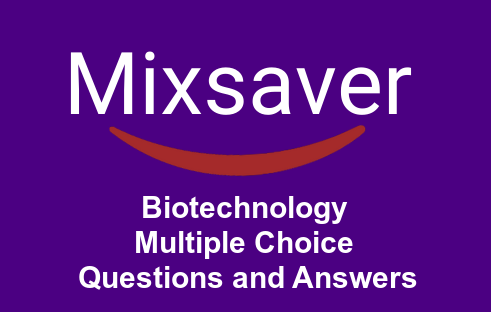NEET Questions on Biotechnology and its Applications | MCQ on Biotechnology and its Applications
1. Protein engineering is used to study the proteins compare the catalytic properties of
(a) normal and mutated form of enzyme
(b) normal form of enzyme
(c) mutated form of enzyme
(d) normal and mutated form of proteins
Ans. a
2. Plasmids that carry genes to provide resistance antibiotics are called
(a) R-plasmids
(b) C-plasmids
(c) A-plasmids
(d) Ti-plasmids
Ans. a
3. DNA sequencing is
(a) nucleoside sequence of mRNA fragments
(b) nucleotide or base sequence of a DNA fragment
(c) nucleotide design of DNA fragment
(d) nucleotide or base sequence of tRNA
Ans. b
4. Cells, in which recombinant DNA multiplies is
(a) E. coli
(b) virus
(c) fungi
(d) algae
Ans. a
5. In order to express human gene in a bacterium, cDNA must be made because bacteria
(a) splice RNA
(b) destroy human DNA
(c) cannot remove introns
(d) have reverse transcriptase
Ans. c
6. Sticky ends are produced by following restriction enzymes except
(a) Pst I
(b) Smal
(c) Hae II
(d) Bam HI
Ans. b
7. Primer DNA, MRNA hybrids are made by using
(a) reverse transcriptase
(b) DNA polymerase
(c) RNA polymerase
(d) DNA hybridase
Ans. a
8. Which of the following could be a restriction enzyme recognition site?
(a) ATGCAT
(b) ATCATC
(c) AAAGGA
(d) ATCCTA
Ans. a
Gate Biotechnology Question Bank | Biotechnology and its Applications NEET MCQs pdf
9. Which of the following restriction enzymes produce blunt ends?
(a) Sma l
(b) Hae III
(c) Alu l
(d) All of these
Ans. d
10. What is the basis of tissue culture technique that enables the cloning of plants?
(a) Plant cells have a semi-rigid cell wall that increases their ability to divide
(b) Plants have no resistance to pathogens, so they need to be grown in sterile conditions
(c) Plant cells are totipotent
(d) Plant cells are pleuripotent
Ans. c
11. Protoplast fusion between Nicotiana glauca and N. langsdorffii was obtained by
(a) Robertis
(b) Carlson
(c) Kuchko
(d) Vasil
Ans. b
12. A’genomic library’ is a term used to describe a
(a) collection of books about genes in DNA technology
(b) collection of known DNA sequences
(c) collection of genes that code for specific protein sequences
(d) culture of bacteria that contain DNA fragments representing the genome of an organism
Ans. d
13. Genetic modification has
(a) made crops more tolerant to abiotic stresses
(b) reduced reliance on chemical pesticides
(c) helped to reduce post harvest losses
(d) All of the above
Ans. d
14. The linking of antibiotic resistance gene with the plasmid vector become possible with the enzyme
(a) DNA ligase
(b) RNA polymerase
(c) DNA polymerase
(d) All of these
Ans. a
15. Aprocedure, through whicha piece of DNA is introduced in a host bacterium is
(a) transduction
(b) transformation
(c) conjugation
(d) rDNA technology
Ans. b
Biotechnology Question Bank | Plant Biotechnology MCQ with Answers pdf | MCQ on Biotechnology and its Applications pdf
16. The cutting of DNA at specific locations became possible with the discovery of
(a) cloning
(b) restriction endonuclease
(c) restriction enzyme
(d) vectors
Ans. b
17. The plasmid vector is cleaved by
(a) exonuclease
(b) ribonuclease
(c) endonuclease
(d) any nuclease
Ans. c
18. A method of cellular defence that takes place in all eukaryotic organisms is
(a) RNA
(b) downstrearn processing
(c) extension
(d) annealing
Ans. b
19. The process by which multiple copies of the gene of interest is synthesised in vitro using two of primers is known as
(a) PCR
(b) gel electrophoresis
(c) downstream processing
(d) genetic printing
Ans. a
20. Now-a-days, the most commonly used matrix in gel electrophoresis is
(a) agarose
(b) ethidium bromide
(c) sulphate bromide
(d) sulphite bromide
Ans. a
21. When an alien DNA is linked with the origin of replication, so that this alien piece of DNA can replicate and multiply itself in the host organism, this can be called as
(a) gene transfer
(b) gel electrophoresis
(c) cloning
(d) transformation
Ans. c
22. In recombinant DNA technology, the plasmid vector DNA is cleaved by
(a) ribonuclease
(b) exonuclease
(c) endonuclease
(d) any nuclease
Ans. c
23. The bacterial resistance to antibiotics is a genetic qualification present in
(a) virus
(b) bacterial DNA
(c) bacterial membrane
(d) plasmid
Ans. d
24. Plasmid that has the ability of integrating into the bacterial DNA are called
(a) nucleotides
(b) hyposomes
(c) virion
(d) episome
Ans. d
Biotechnology and its Applications MCQ with Answers | Biotechnology and its Applications MCQ
25. A gene carried by recombinant DNA is cloned when
(a) its host bacterium divides by binary fission
(b) it is transcribed
(c) it is fragmented by restriction enzymes
(d) it is hybridised
Ans. a
26. DNA of plasmid is
(a) double-stranded and circular
(b) single-stranded and circular
(c) double-stranded and linear
(d) single-stranded and linear
Ans. a
27. Rennet enzyme obtained from calf’s stomach was reported by
(a) A Fleming
(b) Christian Gram
(c) Waksman
(d) Christian Hansen
Ans. b
28. Retroviruses, in animals have the ability to transform normal cell into
(a) dead cell
(b) RNA containing cell
(c) DNA containing cell
(d) cancerous cell
Ans. d
29. The Father of DNA fingerprinting is
(a) Sunder Lal Bahuguna
(b) Vishwanath
(c) Jeffreys
(d) Rockfeller
Ans. c
30. Genetically identical copy of individual cell or gene known as
(a) species
(b) phagemid
(c) clone
(d) plasmid
Ans. c
31. The technique of breakage of DNA fragment and inserting it into another DNA molecule, is related to
(a) gene splicing
(b) gene cloning
(c) gene typing
(d) DNA fingerprinting
Ans. b
32. The number of copies of a gene present in a cell is called
(a) gene dosage
(b) gene pool
(c) gene amplification
(d) gene frequency
Ans. a
33. Type-I restriction enzyme
(a) recognise the specific sequence and cleave DNA at the specific sequence
(b) do not recognise or cleave the specific sequence
(c) recognise specific sequence but cleave non-specific sequen
(d) None of the above
Ans. c
34. Which of the following is not associated with genetic engineering?
(a) Plastids
(b) Plasmids
(c) ATPase
(d) Histones
Ans. c
35. VNTRS are
(a) Variable Number Tandem Repeats
(b) Very Narrow Tandem Repeats
(c) Variable Non-cistronic Transposon Repeats
(d) Valuable Non-cistronic Transposic Regions
Ans. a
36. In a chromosome, there is a specific DNA sequence, which is responsible for initiating replication, known as
(a) vector
(b) origin of replication
(c) recognition sequence
(d) marker gene
Ans. b
37. The cutting of DNA by restriction endonucleases results in the fragments of DNA. These fragments can be separated by a technique known as
(a) PCR
(b) SDS page
(c) Northern blotting
(d) Gel electrophoresis
Ans. d
38. You can see bright orange coloured bands of DNA in a ethidium bromide stained gel exposed to
(a) X-rays
(b) sun rays
(c) UV rays
(d) gamma rays
Ans. c
39. What are important products of yeast fermentation?
(a) Ethanol and acetic acid
(b) Butanol, glycerol and pyric acid
(c) Phenylethanol, amylalcohol and caproiacid
(d) All of the above
Ans. d
40. A thermostable DNA polymerase, which remains active during the high temperature induced denaturation of double-stranded DNA is isolated from a bacterium
(a) E. coli
(b) Thermus aquaticus
(c) Salmonella
(d) Thermus coccus
Ans. b





